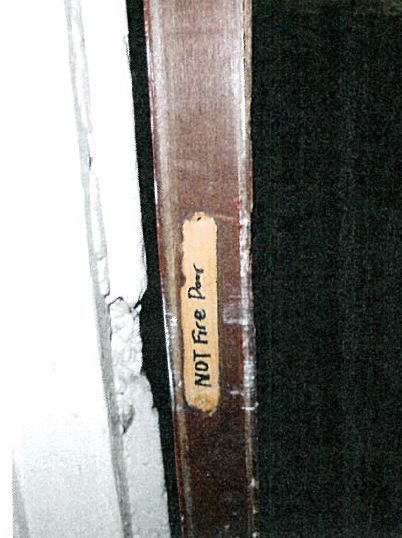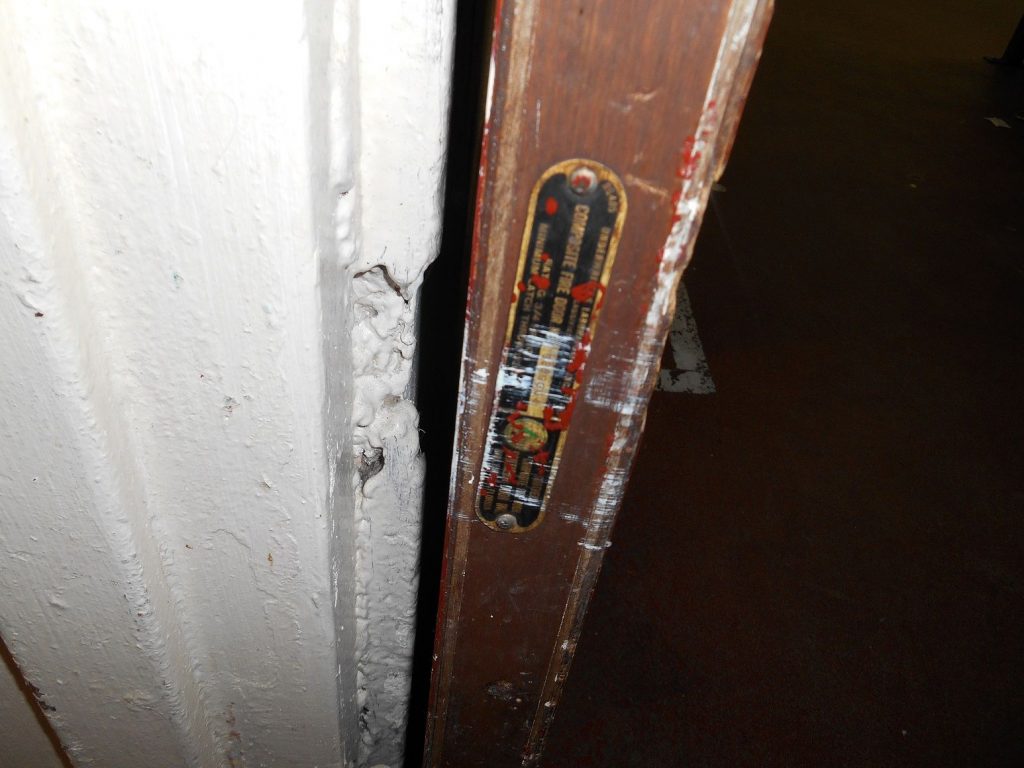Today’s Fixed-it Friday post includes a serious question for all of you to ponder. I’ll get to it in a minute. First…I received the photos below from a code official. He had noted during an inspection that this labeled door was missing a closing device:
When the code official went back, the building owner said he had fixed the problem:
Removing a fire door label is one way to avoid confusion and inspection issues, IF the door is not required to be a fire door. BUT (here’s the important question which I have separated into bullets for your consideration)…
- Is it a code requirement that fire doors must only be used where the fire rating is required?
- Must the fire door label be removed if the fire rating is not required in that location?
- Does the door have to meet the requirements for a fire door assembly (closer, latch, etc.) just because has a label – even if a fire door is not required for that location?
This is not a multiple-choice question…your answer can be yes or no to all of the bullets or yes to some and no to others, and I’d love some explanation as to why you answered that way. I’m looking forward to your comments, and I’ll report back on Monday (I’m holding your comments until then). Have a great weekend!
You need to login or register to bookmark/favorite this content.







I would say no to all questions simply to avoid the same type of confusion created from the pictures in this post.
1. A fire rated door can be used, even if the opening is not required to have one.
As always the base code is minimum, you can go above it.
2. I would say no the label can stay.
Now a business may have to answer questions, like why no closure. So that may be one draw back.
3. Combine answer 1&2,
No, no code section to require a rated door to meet all the code.
Just my opinion, but I don’t see why putting a fire door in a location that didn’t require it should be an issue. If anything, they are going beyond the requirements. I also don’t see any problem with putting a fire door slab in a frame that isn’t fire rated, if that location doesn’t need one. Taking the label off might be a good thing to do to avoid confusion. However, unless the location requires an entire fire rated assembly, I don’t see a reason that you would have to put on listed closers, locks, etc. From the couple of photos, it looks like they had an extra door around, and put it in an existing frame to avoid having to buy a new door. I don’t see any issue with that.
Hi, my answers is no, no and no to the three bullets.
Thanks
I believe the answers are:
No
No
No
This is partially based on experience (I’ve done a ton of healthcare renovations and run into this ALL the time) and logic (it isn’t likely that the code will demand significant retrofit costs to owners whose buildings are expected to evolve).
Although it would be nice if rated doors were not allowed to remain in service when not required (this often causes me to do practically a whole building code review to figure out what is required/not required), I haven’t found code text to back this up (but I haven’t looked too hard to find it either). And by my logic, if there is nothing to state they must be removed, I’d guess the label or hardware would also not need changed.
I’ll be interested to know the correct answers – this isn’t one I’d bet on. Note: an up-to-date life safety plan would also avoid confusion and not incur the retrofit costs of removing unrequired rated doors (and save lots of people time/effort).
I’m reminded of those “Do Not Remove Under Penalty of Law” tags on mattresses. Probably more appropriate for a fire door. The presence of a fire door implies a rated wall. Removing the tag creates confusion and I think the inspector should have required the owner to install a new fire rated door, just for being a wiseguy.
No to all three is what I believe to be correct. But it really depends on AHJ. Several years ago I ran into an AHJ that would not allow a labeled door in a non-fire rated opening due to the above issues. I asked why and he stated years from now when the building is inspected again he might not remember what openings are rated or what if it is a different inspector. I agreed then and took off the offending labels.
My rational mind says…no. Sure, it’s overkill to have a rated door at a non-rated opening…but who it shouldn’t matter. If rest of the hardware should be dependent on the requirements for the opening, not simply the door’s rating. Maybe the label should be removed to facilitate inspectors…but they should probably know better as well.
Of course, “rational” and “code” do not always go hand in hand.
I believe fire doors are installed in non fire rated openings many time and for a myriad of reasons, (I had one in stock, I thought it should be fire rated, arn’t all steel doors fire rated… etc)
If a fire door is installed in a non rated opening, the label should be removed and destroyed.
If it looks like a duck, it must be a duck! If the door has a fire door label on it, it should be treated as a fire door and appropriately furnished as a fire door assembly, self-closing and self-latching
Most of our developer clients used to purchase 20-minute labeled doors for all their doors, whether the opening required a rating or not. The thought was that if there was a remodel and doors were required for a rated corridor, then they would have doors in attic stock that would work, even though they would have to install a new frame and probably modify the hardware. We still have some clients that do this, although since rated corridors in sprinklered office buildings have been going away (except in older high rises, but that’s a whole other story), 20-minute labeled doors aren’t required as much any more and so we are seeing them less on jobs.
I would say that nowadays that rated door frame assemblies typically need to be 1-hour or 90-minute rated, the doors aren’t as readily interchangeable, so rated doors are only used where rated assemblies are required.
This is similar to your post from last year about fire exit devices on non-rated doors. All of our stock hollow metal frames are ordered with an embossment showing they can be fire rated. Whether they are or are not depends on several factors. Some of which we have control over and some we don’t. No code official has ever asked us to grind off the embossment at non-rated openings. Most hinges, locksets, etc… have fire listings stamped into them whether it’s needed or not. I would say there is no problem putting fire rated doors into non-rated openings as long as they meet all other code requirements but, to avoid confusion down the line (because 5 years down the road, who’s going to have a set of plans available showing if a wall is rated or not), I think the label should be removed if not a permanent part of the component.
P.S. Regarding the fire exit devices – Allegion’s own FAQ’s state that a fire exit device is an exit device which is tested for both panic and fire conditions so a fire exit device is ALSO a panic device (still has to meet UL305 standards). So, unless there’s a code difference between the force to open requirements of panic hardware vs. fire exit hardware, I don’t see an issue.
Is it a code requirement that fire doors must only be used where the fire rating is required?
I am not aware of this as a requirement, however, in most jurisdictions I have worked in (private and public sectors), it is standard to practice to install items in accordance with their listing. The provision of a fire-rated assembly can give the impression of a protected assembly and can result in misplaced assumptions. Not all walls are required to be rated, and rated walls can be provided when not required. With the new requirements to label fire and smoke rated walls, barriers and partitions; much of the guess work goes away at post-occupancy inspections.
Must the fire door label be removed if the fire rating is not required in that location?
As long as the fire door is installed per it’s listing, I would permit the label to remain. The potential for the wall to be upgraded.
Does the door have to meet the requirements for a fire door assembly (closer, latch, etc.) just because has a label – even if a fire door is not required for that location?
As stated above, if the door is labeled/listed, I would require installation to those requirements.
I also wanted to add a question:
If a labeled fire door is installed, but not required, is an annual inspection still required?
Hi Michel –
I asked this question of NFPA staff and I was told that the annual inspection would not be required if the door is not required to be fire-rated – even if it has a label on it. The labels do cause confusion though, and the Joint Commission has been telling health care facilities that the door can’t have a fire door label if the label is not required. NFPA staff did not agree with this interpretation when I asked about it, so there’s a conflict between what NFPA 101 and NFPA 80 require, and what the AHJ is requiring. There is more information about that here: http://idighardware.com/2016/11/fire-door-label-mismatch/
– Lori
– Lori
Generally, we consider building code to represent the minimum requirements. Using that logic, we can provide a pair of doors where one is adequate to satisfy egress requirements, or an exit enclosure could be provided where one is not required, or a fire door could be used even if not required. It would follow then that a fire door label could be used in a situation where the fire door is not required by code.
It would also be my opinion that the non-required fire door would not need to be furnished with closing or latching hardware, since the result is still “better than code requires”. I’m not sure why you would do it, but it seems to me that you could.
My take on this situation. We get rated frames in non rated openings all the time in new construction because they cost almost the same and there is no mix up if done that way. I am sure we have rated doors where a rating is not needed and I would say that is fine. I would also say, if it has a label, it had better be complete and in compliance. How is an inspector in the field to be always able to tell if a door needs to be rated or not, so a labeled door must comply to be sure. As to removing the label if a rating is not needed, OK if it leaves no telltale sign to confuse inspectors. The door above just screams, lost label and it may or may not be compliant. One of the biggest complaints I have at this University full of old buildings is, How do I tell which doors need to be rated and inspected, when many are not labeled anymore or never were. We have doors that are over 100 years old. We need a list of labeled doors just to know what to inspect. With over 40,000 locking doors, it will never get done.
Hi Lori.
CMS and The Joint Commission have take the position that if a door has a label and the label can be seen by the general public then it must be a fire door and must be compliant.
Their reasoning is the general public see the label and the general public assumes it is a fire door.
I don’t agree with their conclusion or interpretation because the door does determine the fire / smoke separation wall or barriers. The wall does. Besides, the general public doesn’t read these labels unless they are in the door business.
So, in a health care environment, remove your labels on doors that are not on a fire separation wall.
now that’s rich !! the “general public”.. it occurs to me that the
general public cares about 1 thing and one thing only.. is there
a commotion? if so, where is the nearest door ? maybe included in
that equation in their mind, “a lit exit sign above the door” ?
although that aspect would be a subconscious thought..
1. It is not a code requirement that fire rated doors must only be used at fire rated openings, but why would you go to the added expense of having a rated door installed at a non-rated opening?
2. Yes, if a fire rated door is installed at a non-rated opening, then the label must be removed so as not to cause confusion.
3. Yes, if a fire rated door & frame assembly is installed, then all required associated hardware must be installed per code accordingly in order to maintain the fire rating at which the assembly was tested.
The appearance of both a non-rated door/frame assembly and a fire rated door/frame assembly can be exactly the same, yet the only difference being are the labels on both the door & frame. This is why it’s so important to have labels only at fire rated locations in order to maintain a clear & comprehensive life safety plan of the building.
The hospital I worked in routinely placed used, labeled Fire Doors in unrated openings i.e. office partitions, new storage closets. etc. Office space renovations were an ongoing game of musical chairs due to larger building renovations on different parts of the campus. So larger spaces would be split up and configured to suit the new occupants who would only be there for a few months, then a new occupant would move in and the process would start all over again.
If there were ever any confusion as to whether a particular opening was rated or not, those questions were easily answered after consulting the drawings for the area.
If a door is labeled as a fire door it has to be maintained as a fire door whether a fire door is required for that opening or not. If you are a hospital, TJC surveyors will also get you on this one. This is because in chapter 4 life safety features obvious to the public (like fire doors) have to function as the public would expect them to function. This is the same rule that says you can’t use security cameras disguised as smoke detectors unless they are also smoke detectors.
Older hospital that perhaps were built without automatic fire sprinklers and later had sprinklers added, or have undergone other change-of-use may have fire doors in places they are no longer required. One solution is removing the tags, if a fire door is not required in that location.
First thing, I am not a code expert. Just a guy who has hung a lot of doors.
Q1. No. That is illogical.
Q2. No. But it would avoid a lot of confusion.
Q3. No. But once again the label creates a lot of confusion.
No to all of them.
1)The rating required at the assembly is the minimum rating that will allow the door to pass inspection. There is no provision in IBC or NFPA that I am aware of the precludes you from using a higher rated door.
2)As the DOOR is still rated, I would (as a facilities department) want the label to remain should I ever chose to use it at another location. The label does not claim to rate the assembly, only the component itself.
3)Using a rated door does not change the rating requirement for the assembly. If it’s not rated on the stamped plans, there would be no requirement to bring the additional doorway components up to the rating of the door.
-When I installed, I remember a bunch of jobs where we installed rated doors on every single opening. I wasn’t in the know at that time, but was told that it had to do with our stock, and discount levels from the door manufacturer. I took that to mean we could get the doors less expensively by ordering a greater quantity of a single type, then we could splitting it among types. We were a UL shop, so most preps were done in house to doors we already had in stock.
No, No, and No….
But in older facilities, the battle you will encounter is having the plans available to prove to the inspector its not a fire rated opening.
The burden of proof is normally on the building owner not the inspector…
I would answer NO to all the above only if documentation is noted that the rated opening has been changed from it’s original design due to renovation. Changes such building use, improvements of fire suppression systems; including compartmentalization with rated openings and sprinkler system upgrades.
Is it a code requirement that fire doors must only be used where the fire rating is required?
No, this only makes the building safer.
Must the fire door label be removed if the fire rating is not required in that location?
as much as it would help, the process of removing fire labels might get you into more trouble if you make a mistake.
Does the door have to meet the requirements for a fire door assembly (closer, latch, etc.) just because has a label – even if a fire door is not required for that location?
No, because the doors aren’t the ones that dictate what the requirement are. I feel that if an inspector is checking for fire door compliance, they need to follow a plan or door schedule that tells them the requirements at each opening. How else would they know if an unmarked door is supposed to be rated?
No, a fire door can be placed even if the room and or barrier do not require it.
no, The label does not have to be removed, however if the label remains the door must comply with NFPA 80 which leads to answer 3, Yes, if the door isa labled it must meet all the features of a fire door which includes fire door rated frame, hardware, and gaps.